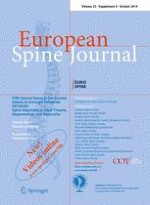Published in:

01-10-2014 | Original Article
Successful correction of sagittal imbalance can be calculated on the basis of pelvic incidence and age
Authors:
Pedro Berjano, Francesco Langella, Maryem-Fama Ismael, Marco Damilano, Sergio Scopetta, Claudio Lamartina
Published in:
European Spine Journal
|
Special Issue 6/2014
Login to get access
Abstract
Introduction
Sagittal imbalance is an independent predictor of outcome in adult degenerative spinal deformity. Restoration of sagittal spinopelvic parameters correlates with a better postoperative outcome. Several methods of preoperative calculation for sagittal correction have been proposed, most of them are geometrical. A non-geometrical method, based on data of spinopelvic relationships in normal subjects that uses the patient’s pelvic incidence and age to calculate target lumbar lordosis and thoracic kyphosis is proposed. The goal of this study is to describe and validate this non-geometrical method in terms of sensitivity and specificity to predict satisfactory spinopelvic alignment.
Materials and methods
Retrospective cohort study of patients operated for sagittal imbalance with pedicle subtraction osteotomies (PSO). Two calculation algorithms [method a: LL = −(32.56 + PI × 0.54), method b: LL = −(PI + 10°)]; in both TK = (PI/r)-LL, see text for definitions] obtain theoretical lumbar lordosis (LL) and thoracic kyphosis (TK) solely based on pelvic incidence and age, for surgical planning. The sample is categorized according to two parameters: planning goals (LL and TK) achieved or not and satisfactory alignment (SVA < 50 mm and PT < 20°) achieved or not. 2 × 2 tables are built and odds ratio, sensitivity and specificity and predictive positive value/predictive negative value (PPV/NPV) are calculated for each planning method. Different levels of tolerance for undercorrection are analyzed to refine the use of the method.
Results
Of the 50 patients included in the study, 23 presented satisfactory alignment postoperatively. With a tolerance of hypocorrection of 10° (LL) and 30° (TK), correction target was achieved in 23 patients according to method a [S = 0.89, Sp = 0.87 %, OR 53.33 (95 % CI 9.677–293.931), p < 0.001], 23 patients according to method b [S = 0.93, Sp = 0.91, OR 131.25 (95 % CI 17–1013), p < 0.001]. The best prediction of satisfactory alignment was obtained with method b and tolerance 0° (LL) and 10° (TK). All patients with complete correction of LL (both methods) achieved good alignment. 22/24 (91 %) patients with less than 10° of undercorrection of LL (method b) achieved good alignment.
Conclusions
Calculation of the target lordosis and kyphosis based only in the value of PI and age is a reliable method that can predict good outcomes in terms of alignment. The rule LL = −(PI + 10°) is an easy to calculate and very effective method of planning for lumbar lordosis and good alignment can be expected with high confidence when the final lordosis is within 10° of undercorrection. Including TK in surgical planning can improve the results in terms of restoration of the less known “spinopelvic balance” parameter.